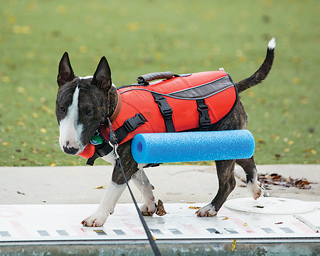 Earlier this spring, as I was working with a young dog, introducing him to a pool for the first time, I was reminded that sometimes instinctual acts are not so instinctual.
Earlier this spring, as I was working with a young dog, introducing him to a pool for the first time, I was reminded that sometimes instinctual acts are not so instinctual.
This can be true with swimming, especially in a swimming pool. This pup approached the pool with confidence until he got to the edge of the pool and then resisted, pulling back on the leash. Knowing to relax the leash and stay calm helped him develop the confidence to take the plunge in just a few approaches.
Teaching your pup to swim can be a fun and rewarding experience, as well as great exercise. However, it can also be challenging. As with all experiences when fear can be involved, the environment needs to be calm and confident. For your pup to experience something new without fear (under the category of aroused energy), it is best to plan ahead. Some key strategies to succeed at a new experience: be calm; move slowly; continue forward momentum; and repeat the exercise until it is consistent.
I would also recommend fitting and familiarizing your pup with a dog life jacket before introducing them to the water. Pair this introduction of the life jacket with another positive activity, such as a fetch exercise, obedience with treats, or a game of hide-n-seek. If you introduce your pup to the life jacket several times over several days, wearing it will become a non-issue.
Finding a great location for introducing your pup to water may take some work. Start by asking friends or dog lovers for recommendations. Some suggestions for the right location: quiet area with little traffic; shallow water leading to deeper; safe area free of debris, like fishing hooks and other dangerous objects; and easy access.
Remember that although most dogs have a natural ability to swim, it is also natural for them to have some fear initially. Make sure you are comfortable and confident with the water and surroundings. Rushing this process can create more fear and trepidation, so be patient. Speaking little and using body language to encourage is also helpful. Stating “Let’s go investigate this” as opposed to, “It’s okay Sweet Baby, don’t be afraid” is helpful as well. Your attitude will influence the experience, so keep it positive.
Along with a calm and confident attitude, some items to bring with you include: a life jacket for your dog; a 6-foot leash; tight-fitting collar or martingale (one that will not slip over the head); and a floating fetch toy.
Now that you have some key strategies to succeed, you have picked a great location, you have all of the supplies you need, it is time to get swimming! As with the life-jacket introduction, pairing the swimming exercise with another positive, fun activity is helpful. Again, this could be fetch, tug, or even going for a walk.
Taking a walk with your pup around or beside the water for ten to twenty minutes can definitely help ease the transition.
If your pup loves to play fetch, first throw the fetch item along the side as opposed to directly in the water. At a river, pond, or calm water’s edge, throw the fetch item parallel with water, each throw going into the water a little more. At poolside, throw fetch item along the side of the pool and then have the dog step in at the stairs a step or so to retrieve, alternating it with fetch along the side of the pool.
After your pup is comfortable with this exercise, but not tired or done playing, throw the fetch item a little further. If he goes in for it, encourage, praise, and continue until your pup is retrieving in deeper water. If the pup resists at any time, you can use the leash to give a quick tug with verbal encouragement, and once the pup complies, relax the leash. Also, at a sign of resistance, you can turn and lead the pup away, then walk back confidently with the leash and continue in the water a little further each time.
Leading your dog into the water and swimming with him is often the extra nudge a dog needs. And once you have your dog swimming, holding him in a settle is beneficial to the experience, too.
Here are few more helpful hints: with a pool, make sure your dog knows where the stairs are – take him in and out the same place and use the leash to guide him in and out numerous times to ensure he does not try to get out at the sides of the pool; make this activity fun for both of you; be consistent and encouraging; keep the sessions short if needed.
Using another dog or two also works great. If your dog is nervous about the water, introduce him to a couple of avid swimmers and have the dogs show them how much fun they’re having in the water. Often, it won’t take long for the prospect of a fun water-romp to overcome the hesitation about trying to swim.
Finally, if you have followed these steps and are not successfully swimming with your dog, you can seek the help of a professional.




